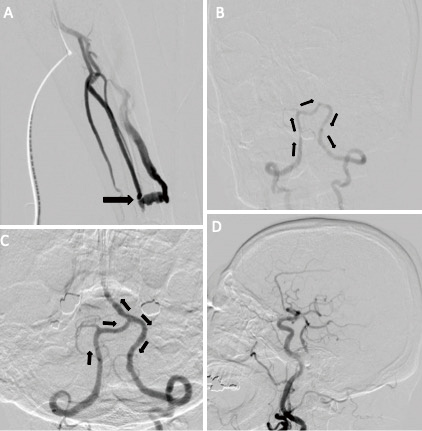Current issue
Displaying 1-38 of 38 articles from this issue
- |<
- <
- 1
- >
- >|
CASE REPORT
-
2024 Volume 11 Pages 1-6
Published: December 31, 2024
Released on J-STAGE: January 16, 2024
Download PDF (2605K) Full view HTML -
2024 Volume 11 Pages 7-11
Published: December 31, 2024
Released on J-STAGE: January 16, 2024
Download PDF (659K) Full view HTML -
2024 Volume 11 Pages 13-18
Published: December 31, 2024
Released on J-STAGE: January 16, 2024
Download PDF (863K) Full view HTML -
2024 Volume 11 Pages 19-25
Published: December 31, 2024
Released on J-STAGE: January 31, 2024
Download PDF (939K) Full view HTML -
2024 Volume 11 Pages 27-32
Published: December 31, 2024
Released on J-STAGE: January 31, 2024
Download PDF (1453K) Full view HTML -
2024 Volume 11 Pages 33-36
Published: December 31, 2024
Released on J-STAGE: January 31, 2024
Download PDF (525K) Full view HTML -
2024 Volume 11 Pages 37-41
Published: December 31, 2024
Released on J-STAGE: February 14, 2024
Download PDF (496K) Full view HTML -
2024 Volume 11 Pages 43-47
Published: December 31, 2024
Released on J-STAGE: February 14, 2024
Download PDF (3381K) Full view HTML -
2024 Volume 11 Pages 49-53
Published: December 31, 2024
Released on J-STAGE: February 14, 2024
Download PDF (508K) Full view HTML -
2024 Volume 11 Pages 55-59
Published: December 31, 2024
Released on J-STAGE: February 14, 2024
Download PDF (1168K) Full view HTML -
2024 Volume 11 Pages 61-67
Published: December 31, 2024
Released on J-STAGE: March 19, 2024
Download PDF (1126K) Full view HTML -
2024 Volume 11 Pages 69-74
Published: December 31, 2024
Released on J-STAGE: March 19, 2024
Download PDF (1286K) Full view HTML -
2024 Volume 11 Pages 75-78
Published: December 31, 2024
Released on J-STAGE: March 19, 2024
Download PDF (494K) Full view HTML -
2024 Volume 11 Pages 79-84
Published: December 31, 2024
Released on J-STAGE: March 19, 2024
Download PDF (1191K) Full view HTML -
2024 Volume 11 Pages 85-91
Published: December 31, 2024
Released on J-STAGE: April 05, 2024
Download PDF (1121K) Full view HTML -
2024 Volume 11 Pages 93-98
Published: December 31, 2024
Released on J-STAGE: April 05, 2024
Download PDF (1002K) Full view HTML -
2024 Volume 11 Pages 99-102
Published: December 31, 2024
Released on J-STAGE: April 05, 2024
Download PDF (618K) Full view HTML -
2024 Volume 11 Pages 103-108
Published: December 31, 2024
Released on J-STAGE: April 05, 2024
Download PDF (1057K) Full view HTML -
2024 Volume 11 Pages 109-112
Published: December 31, 2024
Released on J-STAGE: April 24, 2024
Download PDF (65K) Full view HTML -
2024 Volume 11 Pages 113-117
Published: December 31, 2024
Released on J-STAGE: April 24, 2024
Download PDF (676K) Full view HTML -
2024 Volume 11 Pages 119-123
Published: December 31, 2024
Released on J-STAGE: April 24, 2024
Download PDF (815K) Full view HTML -
A Patient with Tarsal Tunnel Syndrome Associated with the Flexor Digitorum Accessorius Longus Muscle2024 Volume 11 Pages 125-129
Published: December 31, 2024
Released on J-STAGE: May 17, 2024
Download PDF (762K) Full view HTML -
2024 Volume 11 Pages 131-134
Published: December 31, 2024
Released on J-STAGE: May 17, 2024
Download PDF (559K) Full view HTML -
2024 Volume 11 Pages 135-140
Published: December 31, 2024
Released on J-STAGE: May 17, 2024
Download PDF (1005K) Full view HTML -
2024 Volume 11 Pages 141-144
Published: December 31, 2024
Released on J-STAGE: May 28, 2024
Download PDF (488K) Full view HTML -
2024 Volume 11 Pages 145-150
Published: December 31, 2024
Released on J-STAGE: May 28, 2024
Download PDF (277K) Full view HTML -
2024 Volume 11 Pages 151-155
Published: December 31, 2024
Released on J-STAGE: May 28, 2024
Download PDF (742K) Full view HTML -
2024 Volume 11 Pages 157-161
Published: December 31, 2024
Released on J-STAGE: June 13, 2024
Download PDF (1039K) Full view HTML -
2024 Volume 11 Pages 163-168
Published: December 31, 2024
Released on J-STAGE: June 13, 2024
Download PDF (1423K) Full view HTML -
2024 Volume 11 Pages 169-174
Published: December 31, 2024
Released on J-STAGE: June 13, 2024
Download PDF (847K) Full view HTML -
2024 Volume 11 Pages 175-179
Published: December 31, 2024
Released on J-STAGE: June 13, 2024
Download PDF (710K) Full view HTML -
2024 Volume 11 Pages 181-186
Published: December 31, 2024
Released on J-STAGE: June 13, 2024
Download PDF (1378K) Full view HTML -
2024 Volume 11 Pages 187-190
Published: December 31, 2024
Released on J-STAGE: July 27, 2024
Download PDF (531K) Full view HTML -
2024 Volume 11 Pages 191-194
Published: December 31, 2024
Released on J-STAGE: July 27, 2024
Download PDF (914K) Full view HTML -
2024 Volume 11 Pages 195-200
Published: December 31, 2024
Released on J-STAGE: July 27, 2024
Download PDF (1844K) Full view HTML -
2024 Volume 11 Pages 201-206
Published: December 31, 2024
Released on J-STAGE: July 27, 2024
Download PDF (841K) Full view HTML -
2024 Volume 11 Pages 207-211
Published: December 31, 2024
Released on J-STAGE: July 27, 2024
Download PDF (772K) Full view HTML -
2024 Volume 11 Pages 213-219
Published: December 31, 2024
Released on J-STAGE: July 27, 2024
Download PDF (524K) Full view HTML
- |<
- <
- 1
- >
- >|





































